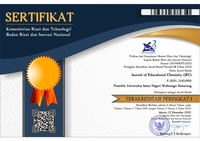Implementation of Flipped Classroom Model on Distance Learning on Volta Cell Application Topics
DOI:
https://doi.org/10.21580/jec.2021.3.2.7568Keywords:
distance learning, flipped classroom, voltaic cellAbstract
This study aims to analyze the implementation of the flipped classroom model in distance learning chemistry in the voltaic cell applications concept. This study used a descriptive method involving 1 teacher and 36 twelfth-grade students. The instrument used was an observation sheet to observe the flipped classroom model's learning process. The results showed that The implementation of the flipped classroom model in chemistry distance learning consists of 3 stages, namely before-class, during-class, and after-class, by combining synchronous and asynchronous activities. Students learn independently through videos with pre-learning questions as guidance in the before-class stage. In the during-class stage, synchronous learning is carried out through zoom meetings to discuss the concept of voltaic cell applications in specific contexts. At the after-class stage, learning is carried out asynchronously by providing a project to design an electrical energy generator that applies to the concept of a voltaic cell. The results showed that the flipped classroom model could be an alternative model for distance learning during the Covid 19 pandemic.
Downloads
References
Abdullah, M. Y., Hussin, S., Hammad, Z. M., & Ismail, K. (2020). Exploring the Effects of Flipped Classroom Model Implementation on EFL Learners' Self-confidence in English Speaking Education and Information Technologies. 295, 223–241.
Ahmed. (2016). Flipped Learning As A New Educational Paradigm: An Analytical Critical Study. European Scientific Journal, 12(10), 417-444.
Andrini, V. S., Pratama, H., & Maduretno, T. W. (2019). The Effect of Flipped Classroom and Project Based Learning Model on Student's Critical Thinking Ability. Journal of Physics: Conference Series, 1171(1). 012010.
Angelina, P. (2019). The Effects of Flipped Learning Implementation on The Students' Achievements in Language Teaching Media Course. Companion Proceedings of the SEADRIC, Juli 2019. Companion Proceedings of the 7th South East Asia Design Research International Conference (SEADRIC 2019), 92–97. Yogyakarta: Sanata Dharma University Press.
Bariah, S. H. (2019). Implementasi E-learning dengan Model Flipped Classroom dalam Aktivitas Belajar Siswa pada Mata Pelajaran Sistem Komputer. Jurnal Petik, 5(2), 1–8.
Bishop, J. L., & Verleger, M. A. (2013). The Flipped Classroom: A Survey of The Research. 120th American Society for Engineering Education Annual Conference and Exposition, 30, 1-18.
Cevikbas, M., & Kaiser, G. (2020). Flipped Classroom as a Reform-Oriented Approach to Teaching Mathematics. ZDM-Mathematics Education, 52(7), 1291–1305.
Fibonacci, A., Wahid, A., Lathifa, U., Zammi, M. & Wibowo, T. (2021). Development of Chemistry E-Module Flip Pages Based on Chemistry Triplet Representation and Unity of Sciences for Online Learning. J. Phys.: Conf. Ser., 1796, 012110.
Firdaus, F., Muntaqo, R., & Trisnowati, E. (2020). Analysis of Student Readiness for Blended Learning Model Implementation in Industrial Era 4.0. Indonesian Journal of Science and Education, 4(1), 48-56.
French, H., Gray, M., Krakauer, M. G., Bonachea, E. M., Carbajal, M., Payne, A., Vasquez, M. M., Rubinos, L., Falck, A., Izatt, S. & Dadiz, R. (2018). Flipping the Classroom: A National Pilot Curriculum for Physiology in Neonatal–Perinatal Medicine. Journal of Perinatology, 38(10), 1420–1427.
Hawi, F. M., & Sudira, P. (2019). The Effect of Blended Learning Model to Improve the Conceptual Understanding of Computer and Network Engineering Students. Journal of Physics: Conference Series, 1413(1). 012023.
Hwang, G. J. & Lai, C. L. (2017). Facilitating and Bridging Out-Of-Class and In-Class Learning: An Interactive E-BookBased Flipped Learning Approach for Math Courses. Educational Technology & Society, 20(1), 184-197.
Ningsih, L, K. (2020). Kejenuhan Belajar Masa Pandemi Covid-19 Siswa SMA Di Kedungwungu Indramayu. Skripsi tidak dipublikasikan. Surakarta: Universitas Muhammadiyah Surakarta.
Pujiasih, E. (2020). Membangun Generasi Emas dengan Variasi Pembelajaran Online di Masa Pandemi Covid-19. Ide guru: Jurnal Karya Ilmiah Guru, 5(1), 42–48.
Rohmah, I. I. T., Saleh, M., Faridi, A., & Fitriati, S. W. (2019). Penerapan Model Pembelajaran Flipped Classroom Berbasis Weblog pada Kelas Content and Language Integrated Learning (CLIL). Prosiding Seminar Nasional Pascasarjana. 1, 357–364.
Rusnawati, M. D. (2020). Implementasi Flipped Classroom Terhadap Hasil dan Motivasi Belajar Siswa. Jurnal Imiah Pendidikan dan Pembelajaran, 4(1), 139–150.
Setiawan, T. H., & Aden. (2020). Efektifitas Penerapan Blended Learning dalam Upaya Meningkatkan Kemampuan Akademik Mahasiswa Melalui Jejaring Schoology di Masa Pandemi Covid-19. Jurnal Pembelajaran Matematika Inovatif, 3(5), 493–506.
Sopandi, W., Kadarohman, A., Sugandi, E., & Farida, Y. (2014). Posing Pre-Teaching Question in Chemistry Course: An Effort to Improve Reading Habits, Reading Comprehension and Learning Achievement. Proceedingsof WALS International Conference, 441- 448. Bandung: UPI Press.
Sugiyono. (2010). Metode Penelitian Pendidikan. Bandung: Alfabeta.
Van Alten, D. C. D., Phielix, C., Janssen, J., & Kester, L. (2019). Effects of Flipping The Classroom on Learning Outcomes and Satisfaction: A Meta-Analysis. Educational Research Review, 28, 1–18.
Wang, Y., Huang, X., Schunn, C. D., Zou, Y., & Ai, W. (2019). Redesigning Flipped Classrooms: A Learning Model and Its Effects on Student Perceptions. Higher Education, 78(4), 711–728.
Downloads
Published
How to Cite
Issue
Section
License
The copyright of the received article shall be assigned to the journal as the publisher of the journal. The intended copyright includes the right to publish the article in various forms (including reprints). The journal maintains the publishing rights to the published articles.
Authors are permitted to disseminate published articles by sharing the link/DOI of the article at the journal. Authors are allowed to use their articles for any legal purposes deemed necessary without written permission from the journal with an acknowledgment of initial publication to this journal.

This work is licensed under a Creative Commons Attribution-NonCommercial-ShareAlike 4.0 International License.


